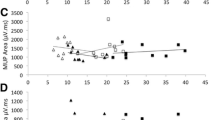Abstract
Surface EMG was recorded from both right and left aspects of 18 muscle groups for the purpose of establishing a data base of normative EMG levels. A scanning electrode permitted easy and rapid EMG measurement from 52 male and 51 female college students, both sitting and standing. Several a posteriori analyses of variance revealed sex differences in the masseter, occipital, posterior cervical, upper trapezius, latissimus dorsi, and anterior tibialis. Similarly, there were side differences for the anterior temporalis, occipitalis, splenius capitus, trapezius, paraspinalis, and soleus. The analyses also revealed interactions among sex, position, and side for various measures on the trapezius. The data show that females tend to muscle brace more than males in the upper extremities. The study provides data for normative comparisons and helps to plan and interpret future EMG studies.
Similar content being viewed by others
References
Arena, J. G., Blanchard, E. B., Andrasik, F., Cotch, P. A., & Myers, P. E. (1983). Reliability of psychophysiological assessment.Behavior Research and Therapy, 21, 447–460.
Basmajian, J. V. (1972). Electromyography comes of age.Science, 176, 603–609.
Blanchard, E. B., Andrasik, F., Ahles, T. A., Feders, S. J., & O'Keefe, D. (1980). Migraine and tension headache: A Meta-analytic review.Behavior Therapy, 11, 613–631.
Chen, W. (1983). Retention of EMG biofeedback relaxation training.Perceptual and Motor Skills, 65, 671–674.
Cram, J. R. (1985).J & J instrument and clinical manual. Poulsbo, WA: J & J Enterprises.
Cram, J. R., & Steger, J. C. (1983). EMG scanning in the diagnosis of chronic pain.Biofeedback and Self-Regulation, 8(2), 229–241.
Moss, R. A., Garrett, J., & Chiodo, J. F. (1982). Temporomandibular joint dysfunction and myofascial pain dysfunction syndromes: Parameters, etiology, and treatment.Psychological Bulletin, 92, 331–346.
O'Connell, M. F., & Yeaton, S. P. (1981). Generalized muscle changes during EMG relaxation training.Psychophysiology, 18(1), 56–61.
Olton, D. S., & Noonberg, A. R. (1980).Biofeedback: Clinical applications in behavioral medicine. Englewood Cliffs, NJ: Prentice-Hall.
Waddell, G., Main, C. J., Morris, E. W., Venner, R. M., Rae, P. S., Sharmy, S. H., & Galloway, H. (1982). Normality and reliability in clinical assessment of backache.British Medical Journal, 284, 1–12.
Wolf, S. F., Basmajian, J. V., Russe, T. C., & Kutner, M. (1979). Normative data on low back mobility and activity levels.American Journal of Physical Medicine, 58(5), 217–229.
Author information
Authors and Affiliations
Rights and permissions
About this article
Cite this article
Matheson, D.W., Toben, T.P. & de la Cruz, D.E. EMG scanning: Normative data. J Psychopathol Behav Assess 10, 9–20 (1988). https://doi.org/10.1007/BF00962981
Accepted:
Issue Date:
DOI: https://doi.org/10.1007/BF00962981




